ignition BMW X5 2005 E53 Central Body Electronics Workshop Manual
[x] Cancel search | Manufacturer: BMW, Model Year: 2005, Model line: X5, Model: BMW X5 2005 E53Pages: 64, PDF Size: 4.03 MB
Page 8 of 64
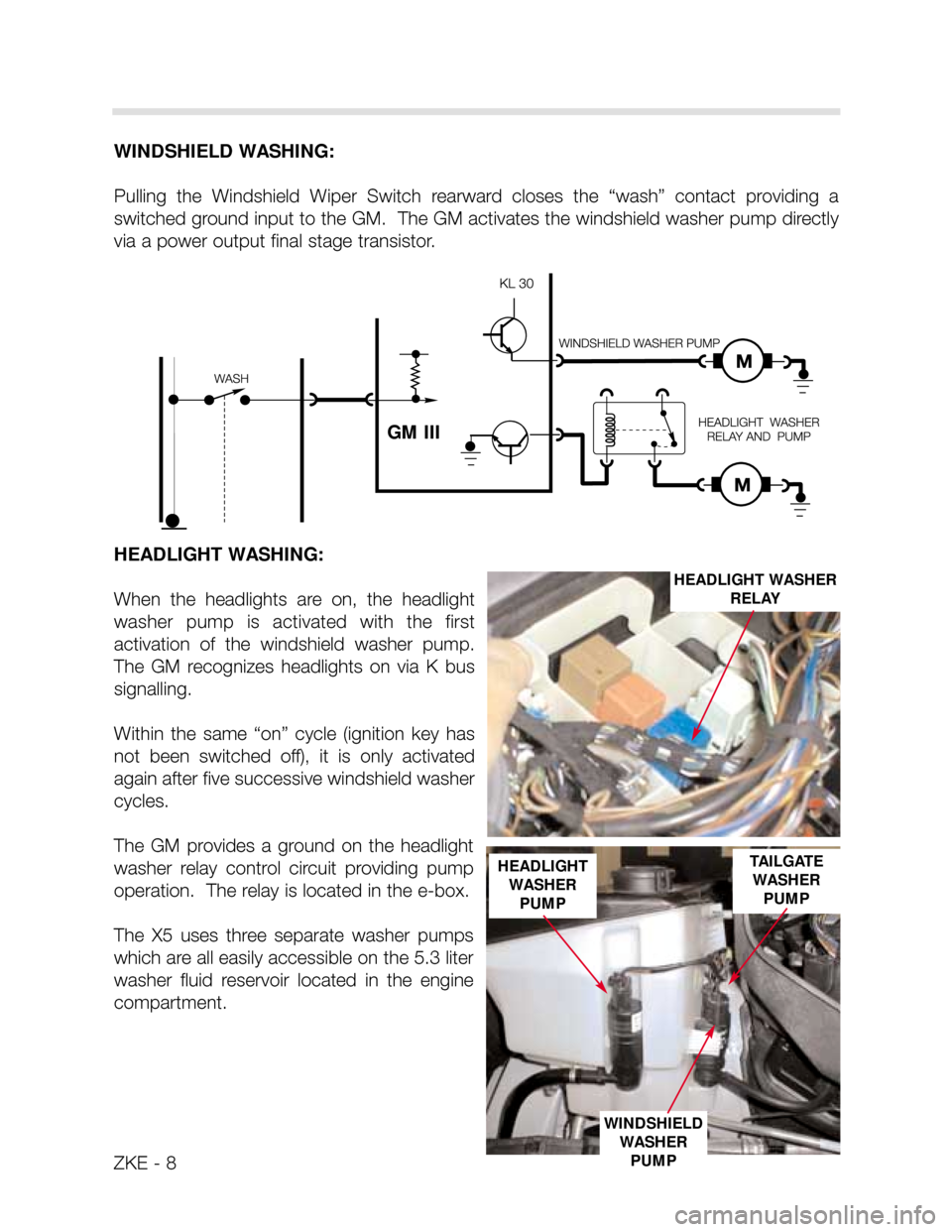
ZKE - 8
WINDSHIELD WASHING:
Pulling the Windshield Wiper Switch rearward closes the “wash” contact providing a
switched ground input to the GM. The GM activates the windshield washer pump directly
via a power output final stage transistor.
HEADLIGHT WASHING:
When the headlights are on, the headlight
washer pump is activated with the first
activation of the windshield washer pump.
The GM recognizes headlights on via K bus
signalling.
Within the same “on” cycle (ignition key has
not been switched off), it is only activated
again after five successive windshield washer
cycles.
The GM provides a ground on the headlight
washer relay control circuit providing pump
operation. The relay is located in the e-box.
The X5 uses three separate washer pumps
which are all easily accessible on the 5.3 liter
washer fluid reservoir located in the engine
compartment.
GM III
HEADLIGHT WASHER
RELAY
HEADLIGHT
WASHER
PUMP
WINDSHIELD
WASHER
PUMP
TAILGATE
WASHER
PUMP
Page 12 of 64
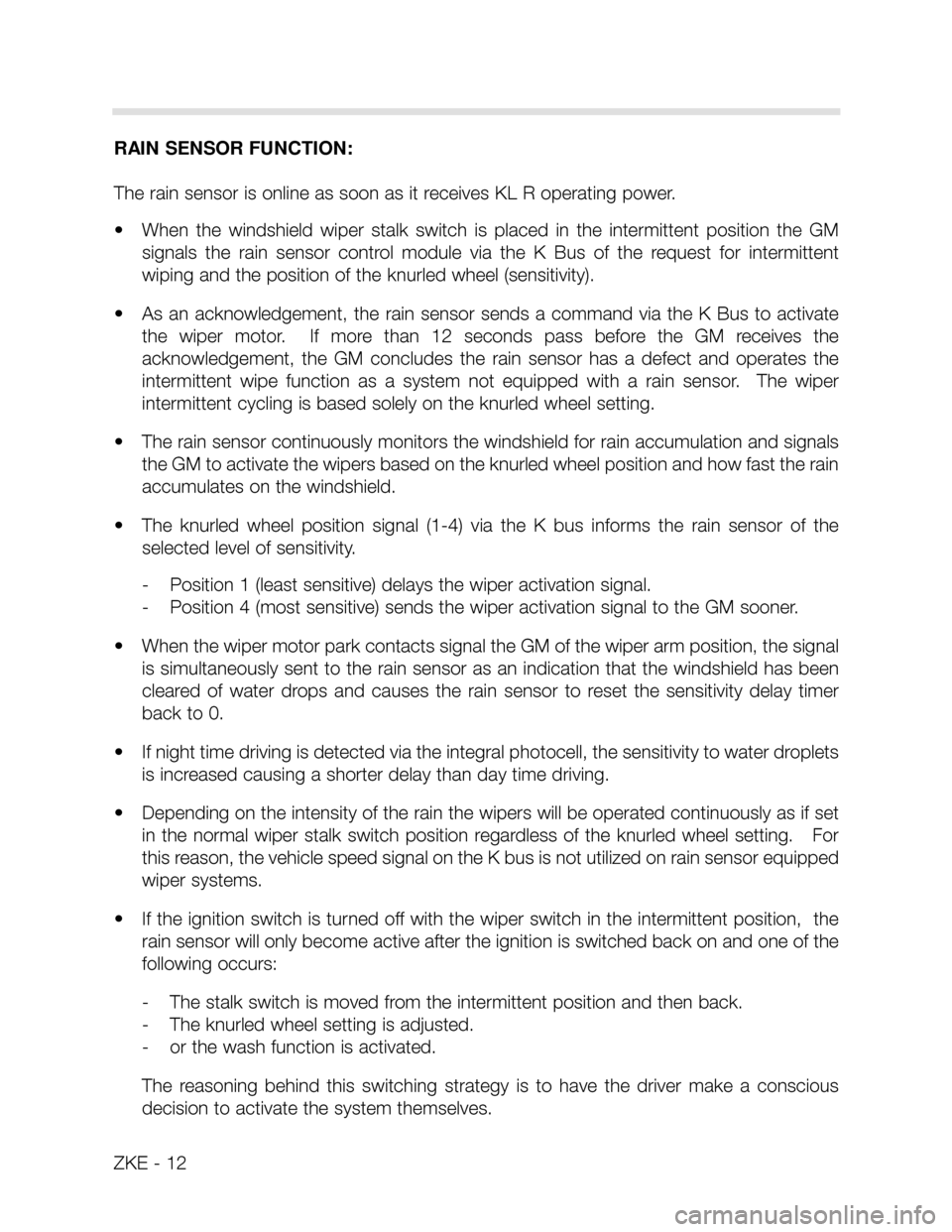
ZKE - 12
RAIN SENSOR FUNCTION:
The rain sensor is online as soon as it receives KL R operating power.
• When the windshield wiper stalk switch is placed in the intermittent position the GM
signals the rain sensor control module via the K Bus of the request for intermittent
wiping and the position of the knurled wheel (sensitivity).
• As an acknowledgement, the rain sensor sends a command via the K Bus to activate
the wiper motor. If more than 12 seconds pass before the GM receives the
acknowledgement, the GM concludes the rain sensor has a defect and operates the
intermittent wipe function as a system not equipped with a rain sensor. The wiper
intermittent cycling is based solely on the knurled wheel setting.
• The rain sensor continuously monitors the windshield for rain accumulation and signals
the GM to activate the wipers based on the knurled wheel position and how fast the rain
accumulates on the windshield.
• The knurled wheel position signal (1-4) via the K bus informs the rain sensor of the
selected level of sensitivity.
- Position 1 (least sensitive) delays the wiper activation signal.
- Position 4 (most sensitive) sends the wiper activation signal to the GM sooner.
• When the wiper motor park contacts signal the GM of the wiper arm position, the signal
is simultaneously sent to the rain sensor as an indication that the windshield has been
cleared of water drops and causes the rain sensor to reset the sensitivity delay timer
back to 0.
• If night time driving is detected via the integral photocell, the sensitivity to water droplets
is increased causing a shorter delay than day time driving.
• Depending on the intensity of the rain the wipers will be operated continuously as if set
in the normal wiper stalk switch position regardless of the knurled wheel setting. For
this reason, the vehicle speed signal on the K bus is not utilized on rain sensor equipped
wiper systems.
• If the ignition switch is turned off with the wiper switch in the intermittent position, the
rain sensor will only become active after the ignition is switched back on and one of the
following occurs:
- The stalk switch is moved from the intermittent position and then back.
- The knurled wheel setting is adjusted.
- or the wash function is activated.
The reasoning behind this switching strategy is to have the driver make a conscious
decision to activate the system themselves.
Page 14 of 64
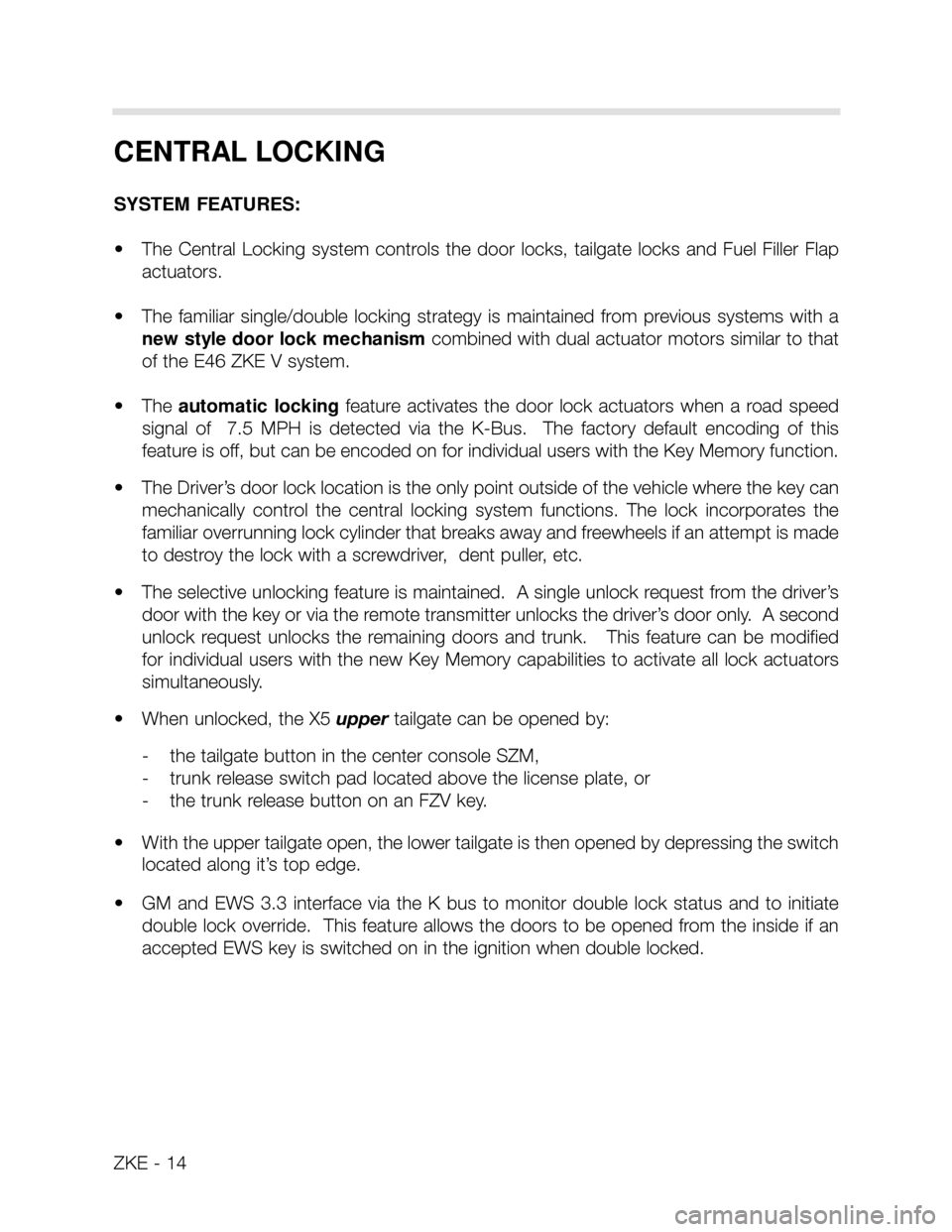
ZKE - 14
CENTRAL LOCKING
SYSTEM FEATURES:
• The Central Locking system controls the door locks, tailgate locks and Fuel Filler Flap
actuators.
• The familiar single/double locking strategy is maintained from previous systems with a
new style door lock mechanismcombined with dual actuator motors similar to that
of the E46 ZKE V system.
• The automatic locking feature activates the door lock actuators when a road speed
signal of 7.5 MPH is detected via the K-Bus. The factory default encoding of this
feature is off, but can be encoded on for individual users with the Key Memory function.
• The Driver’s door lock location is the only point outside of the vehicle where the key can
mechanically control the central locking system functions. The lock incorporates the
familiar overrunning lock cylinder that breaks away and freewheels if an attempt is made
to destroy the lock with a screwdriver, dent puller, etc.
• The selective unlocking feature is maintained. A single unlock request from the driver’s
door with the key or via the remote transmitter unlocks the driver’s door only. A second
unlock request unlocks the remaining doors and trunk. This feature can be modified
for individual users with the new Key Memory capabilities to activate all lock actuators
simultaneously.
• When unlocked, the X5 uppertailgate can be opened by:
- the tailgate button in the center console SZM,
- trunk release switch pad located above the license plate, or
- the trunk release button on an FZV key.
• With the upper tailgate open, the lower tailgate is then opened by depressing the switch
located along it’s top edge.
• GM and EWS 3.3 interface via the K bus to monitor double lock status and to initiate
double lock override. This feature allows the doors to be opened from the inside if an
accepted EWS key is switched on in the ignition when double locked.
Page 22 of 64
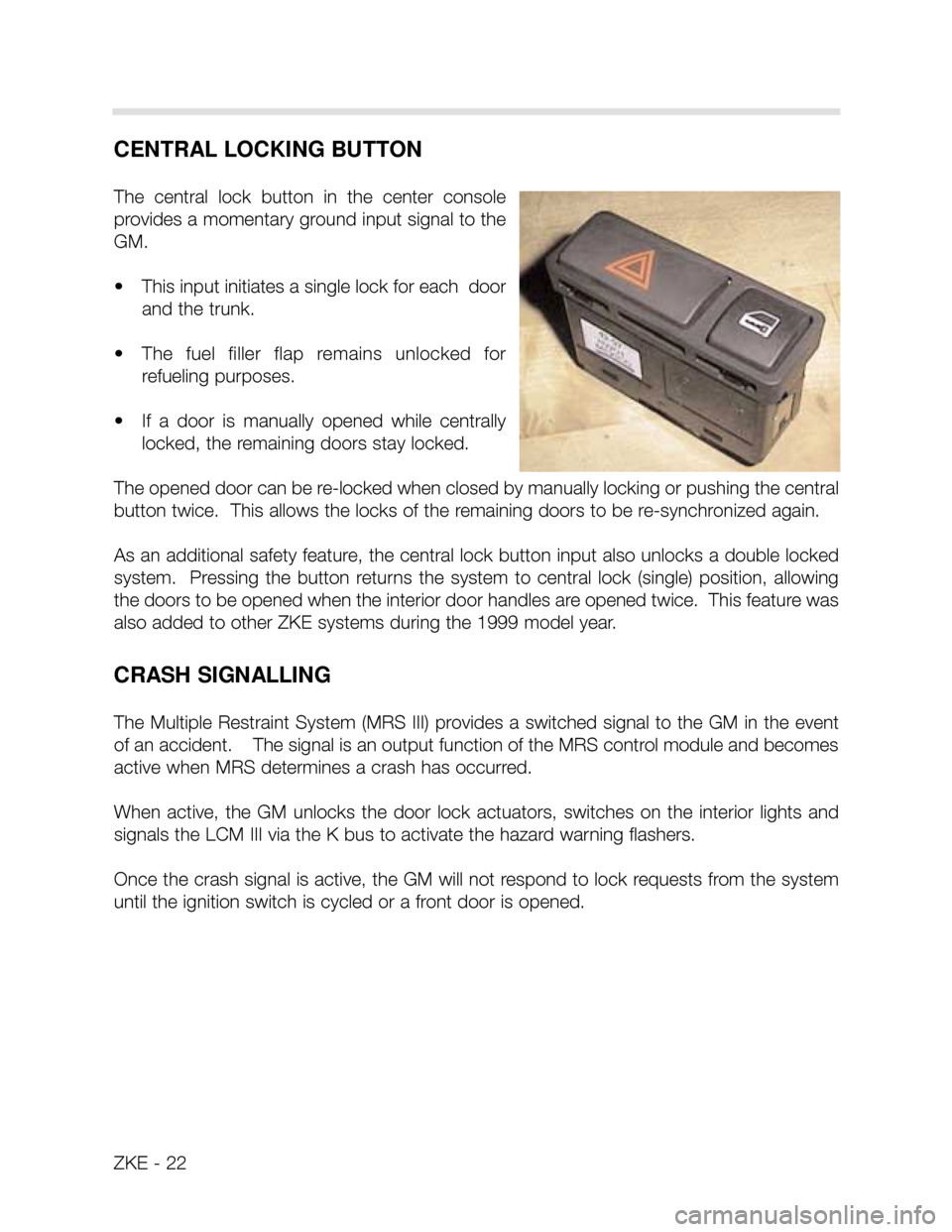
ZKE - 22
CENTRAL LOCKING BUTTON
The central lock button in the center console
provides a momentary ground input signal to the
GM.
• This input initiates a single lock for each door
and the trunk.
• The fuel filler flap remains unlocked for
refueling purposes.
• If a door is manually opened while centrally
locked, the remaining doors stay locked.
The opened door can be re-locked when closed by manually locking or pushing the central
button twice. This allows the locks of the remaining doors to be re-synchronized again.
As an additional safety feature, the central lock button input also unlocks a double locked
system. Pressing the button returns the system to central lock (single) position, allowing
the doors to be opened when the interior door handles are opened twice. This feature was
also added to other ZKE systems during the 1999 model year.
CRASH SIGNALLING
The Multiple Restraint System (MRS III) provides a switched signal to the GM in the event
of an accident. The signal is an output function of the MRS control module and becomes
active when MRS determines a crash has occurred.
When active, the GM unlocks the door lock actuators, switches on the interior lights and
signals the LCM III via the K bus to activate the hazard warning flashers.
Once the crash signal is active, the GM will not respond to lock requests from the system
until the ignition switch is cycled or a front door is opened.
Page 25 of 64
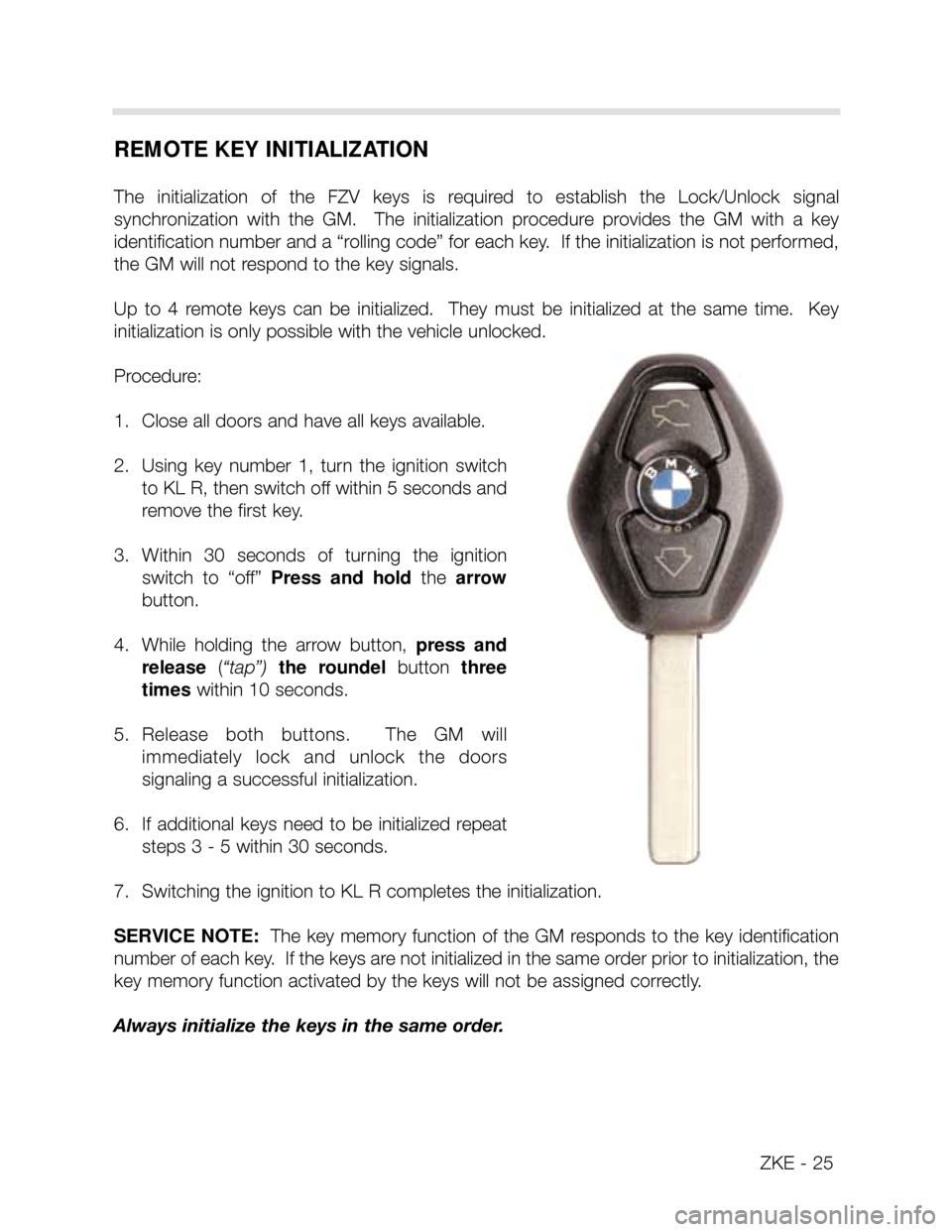
REMOTE KEY INITIALIZATION
The initialization of the FZV keys is required to establish the Lock/Unlock signal
synchronization with the GM. The initialization procedure provides the GM with a key
identification number and a “rolling code” for each key. If the initialization is not performed,
the GM will not respond to the key signals.
Up to 4 remote keys can be initialized. They must be initialized at the same time. Key
initialization is only possible with the vehicle unlocked.
Procedure:
1. Close all doors and have all keys available.
2. Using key number 1, turn the ignition switch
to KL R, then switch off within 5 seconds and
remove the first key.
3. Within 30 seconds of turning the ignition
switch to “off” Press and holdthe arrow
button.
4. While holding the arrow button, press and
release(“tap”) the roundel button three
timeswithin 10 seconds.
5. Release both buttons. The GM will
immediately lock and unlock the doors
signaling a successful initialization.
6. If additional keys need to be initialized repeat
steps 3 - 5 within 30 seconds.
7. Switching the ignition to KL R completes the initialization.
SERVICE NOTE:The key memory function of the GM responds to the key identification
number of each key. If the keys are not initialized in the same order prior to initialization, the
key memory function activated by the keys will not be assigned correctly.
Always initialize the keys in the same order.
ZKE - 25
Page 26 of 64
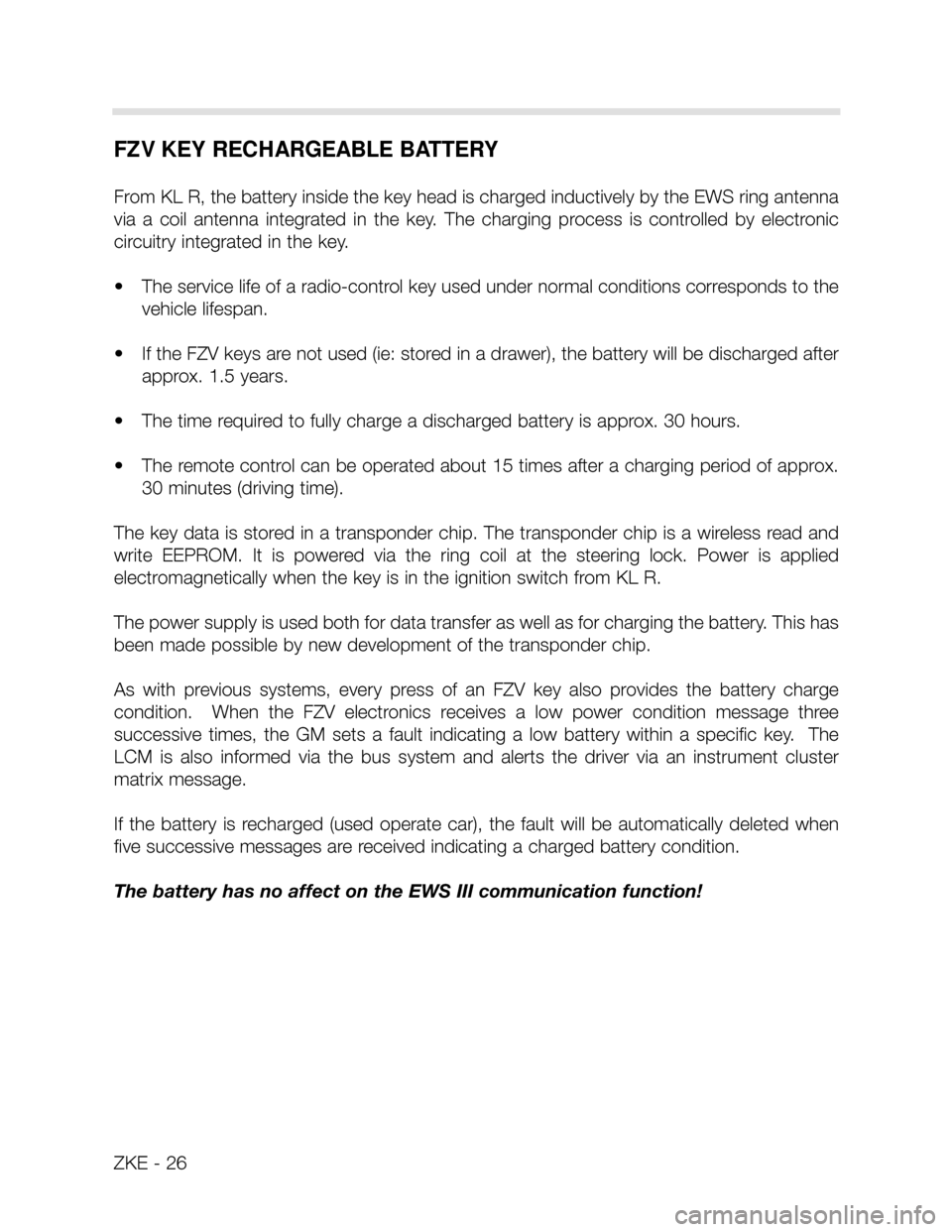
FZV KEY RECHARGEABLE BATTERY
From KL R, the battery inside the key head is charged inductively by the EWS ring antenna
via a coil antenna integrated in the key. The charging process is controlled by electronic
circuitry integrated in the key.
• The service life of a radio-control key used under normal conditions corresponds to the
vehicle lifespan.
• If the FZV keys are not used (ie: stored in a drawer), the battery will be discharged after
approx. 1.5 years.
• The time required to fully charge a discharged battery is approx. 30 hours.
• The remote control can be operated about 15 times after a charging period of approx.
30 minutes (driving time).
The key data is stored in a transponder chip. The transponder chip is a wireless read and
write EEPROM. It is powered via the ring coil at the steering lock. Power is applied
electromagnetically when the key is in the ignition switch from KL R.
The power supply is used both for data transfer as well as for charging the battery. This has
been made possible by new development of the transponder chip.
As with previous systems, every press of an FZV key also provides the battery charge
condition. When the FZV electronics receives a low power condition message three
successive times, the GM sets a fault indicating a low battery within a specific key. The
LCM is also informed via the bus system and alerts the driver via an instrument cluster
matrix message.
If the battery is recharged (used operate car), the fault will be automatically deleted when
five successive messages are received indicating a charged battery condition.
The battery has no affect on the EWS III communication function!
ZKE - 26
Page 31 of 64
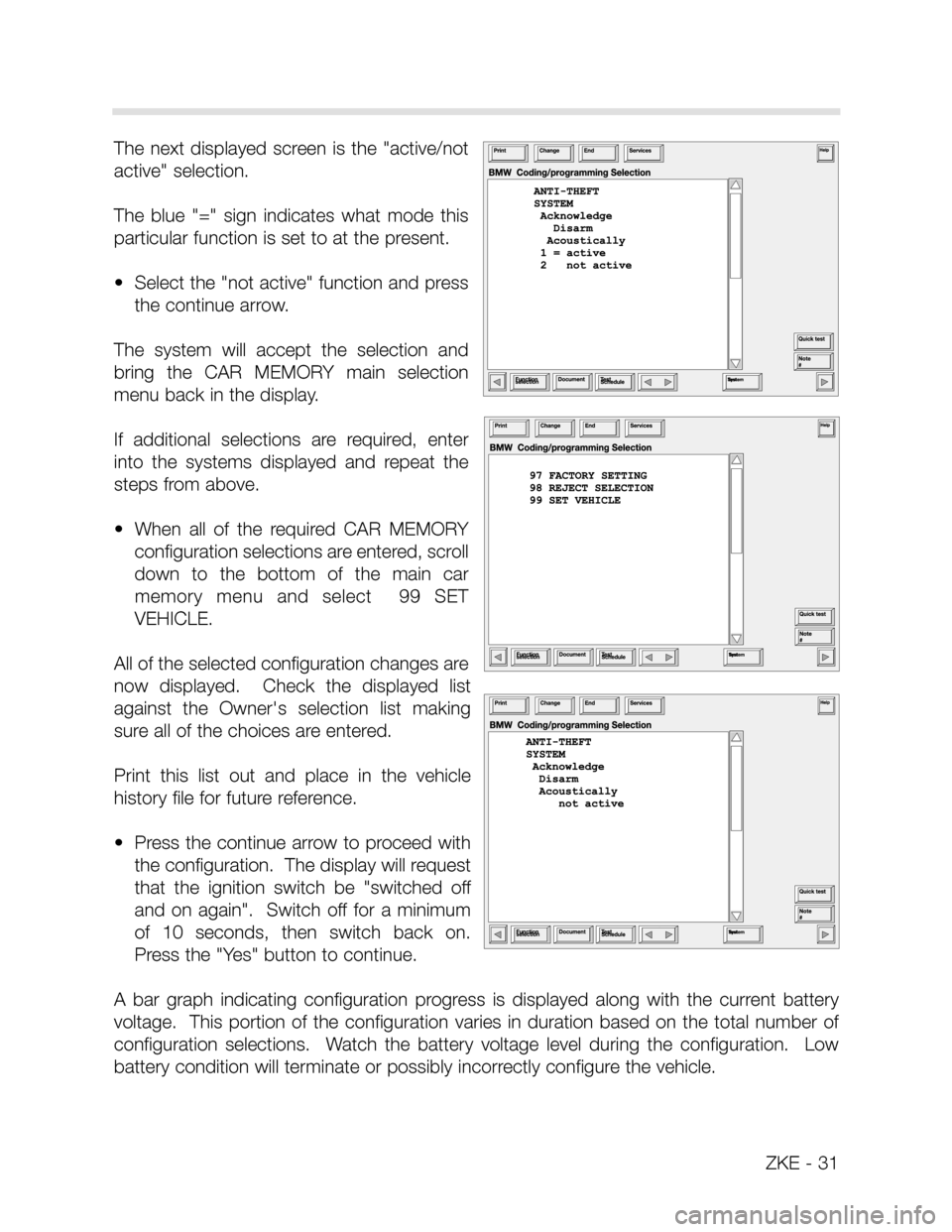
ZKE - 31
The next displayed screen is the "active/not
active" selection.
The blue "=" sign indicates what mode this
particular function is set to at the present.
• Select the "not active" function and press
the continue arrow.
The system will accept the selection and
bring the CAR MEMORY main selection
menu back in the display.
If additional selections are required, enter
into the systems displayed and repeat the
steps from above.
• When all of the required CAR MEMORY
configuration selections are entered, scroll
down to the bottom of the main car
memory menu and select 99 SET
VEHICLE.
All of the selected configuration changes are
now displayed. Check the displayed list
against the Owner's selection list making
sure all of the choices are entered.
Print this list out and place in the vehicle
history file for future reference.
• Press the continue arrow to proceed with
the configuration. The display will request
that the ignition switch be "switched off
and on again". Switch off for a minimum
of 10 seconds, then switch back on.
Press the "Yes" button to continue.
A bar graph indicating configuration progress is displayed along with the current battery
voltage. This portion of the configuration varies in duration based on the total number of
configuration selections. Watch the battery voltage level during the configuration. Low
battery condition will terminate or possibly incorrectly configure the vehicle.
Page 32 of 64
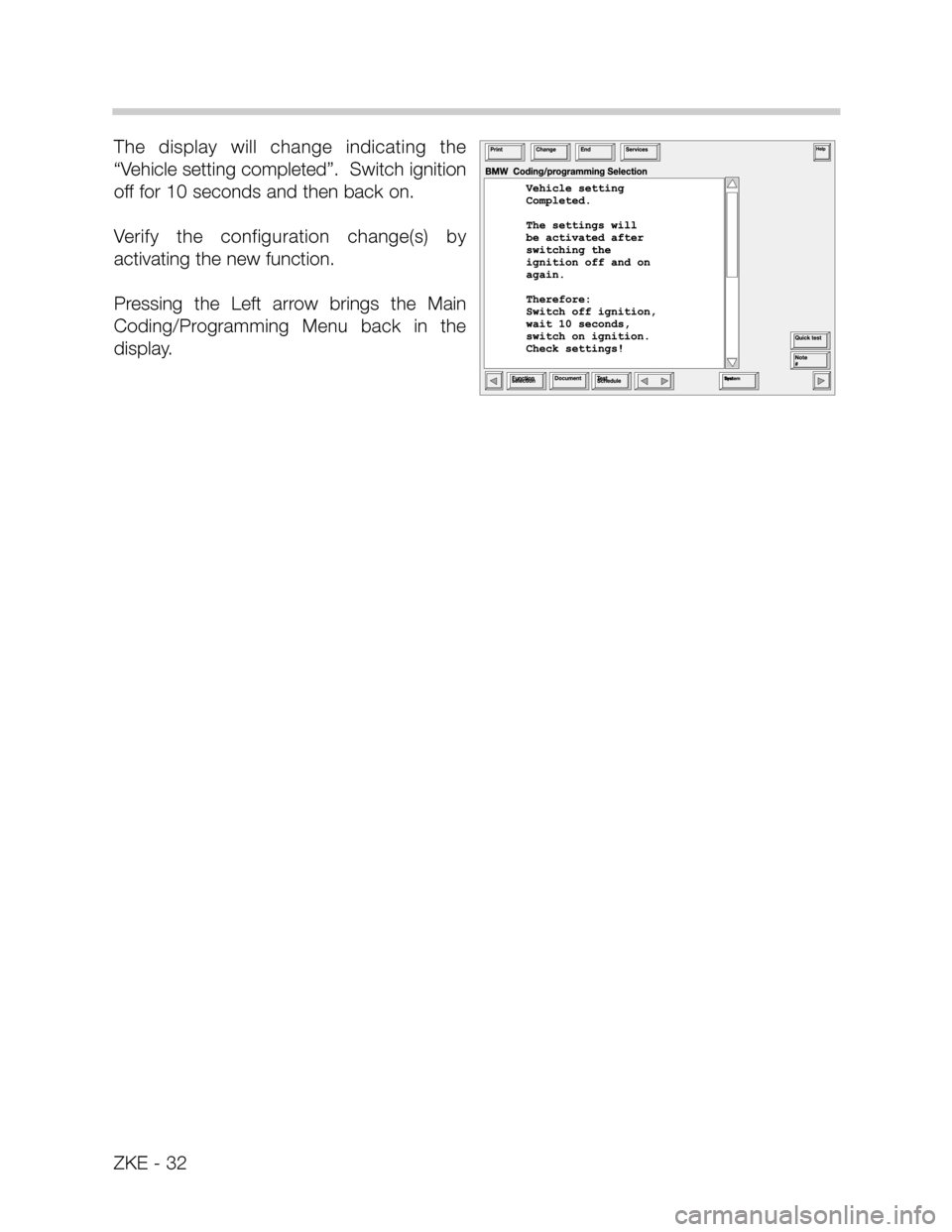
The display will change indicating the
“Vehicle setting completed”. Switch ignition
off for 10 seconds and then back on.
Verify the configuration change(s) by
activating the new function.
Pressing the Left arrow brings the Main
Coding/Programming Menu back in the
display.
ZKE - 32
Page 33 of 64
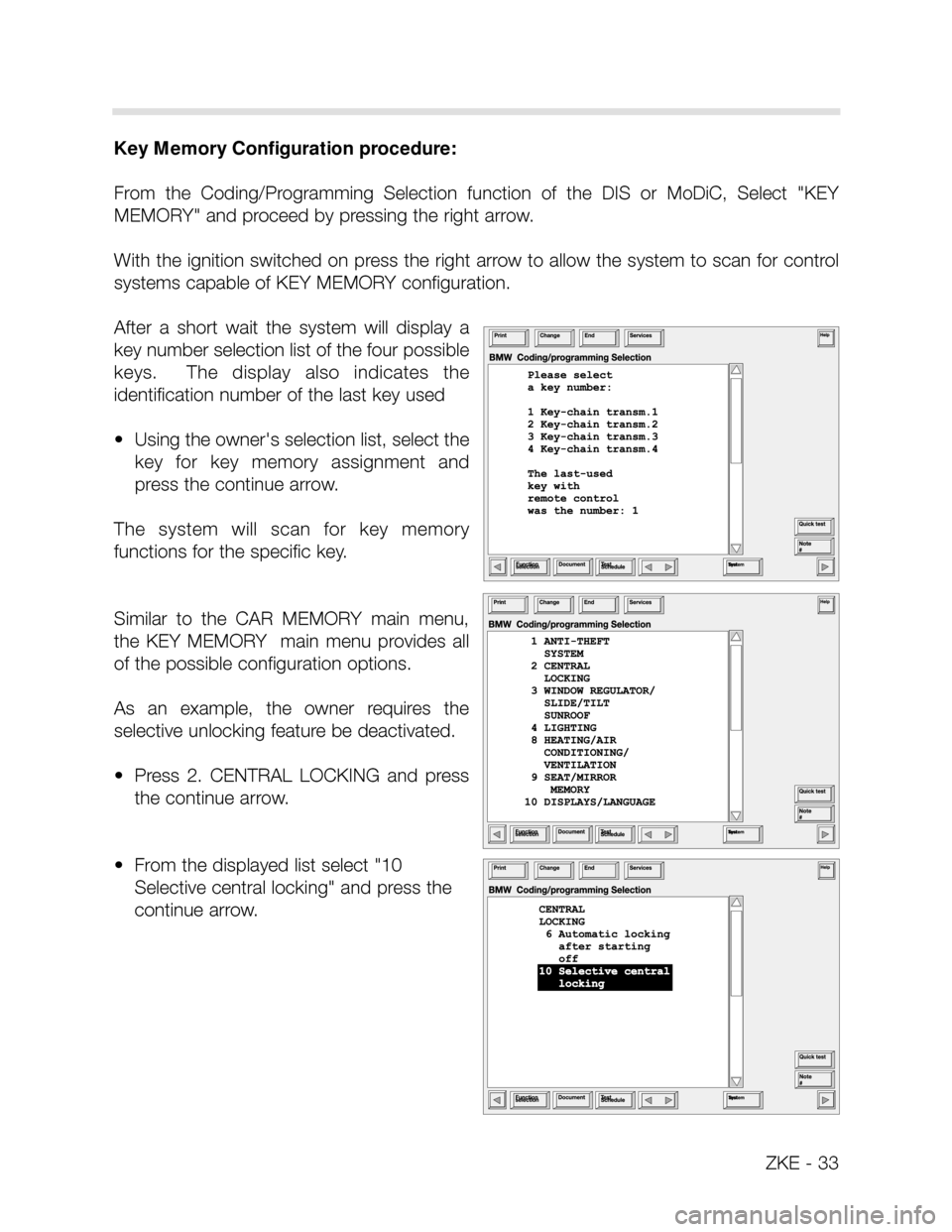
ZKE - 33
Key Memory Configuration procedure:
From the Coding/Programming Selection function of the DIS or MoDiC, Select "KEY
MEMORY" and proceed by pressing the right arrow.
With the ignition switched on press the right arrow to allow the system to scan for control
systems capable of KEY MEMORY configuration.
After a short wait the system will display a
key number selection list of the four possible
keys. The display also indicates the
identification number of the last key used
• Using the owner's selection list, select the
key for key memory assignment and
press the continue arrow.
The system will scan for key memory
functions for the specific key.
Similar to the CAR MEMORY main menu,
the KEY MEMORY main menu provides all
of the possible configuration options.
As an example, the owner requires the
selective unlocking feature be deactivated.
• Press 2. CENTRAL LOCKING and press
the continue arrow.
• From the displayed list select "10
Selective central locking" and press the
continue arrow.
Page 34 of 64
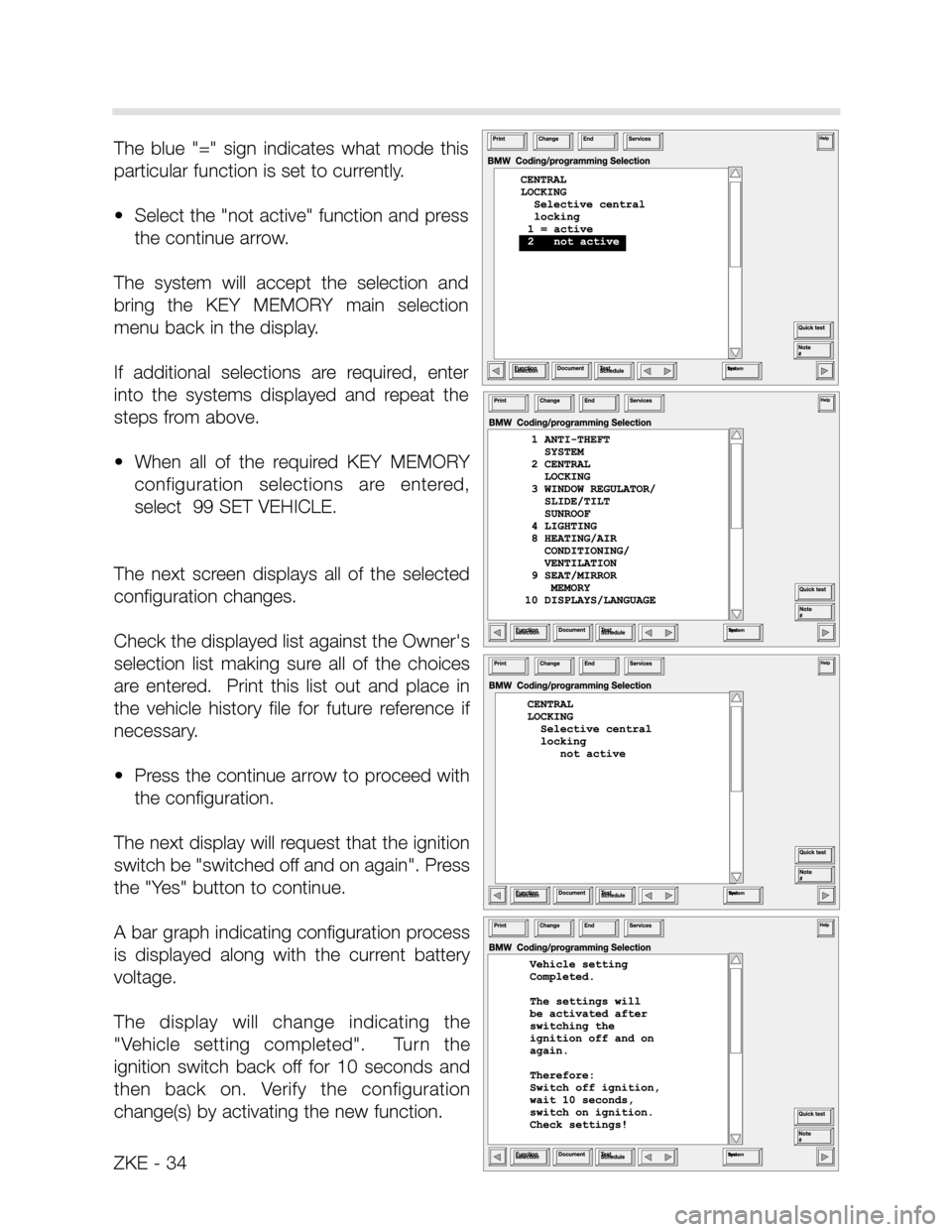
ZKE - 34
The blue "=" sign indicates what mode this
particular function is set to currently.
• Select the "not active" function and press
the continue arrow.
The system will accept the selection and
bring the KEY MEMORY main selection
menu back in the display.
If additional selections are required, enter
into the systems displayed and repeat the
steps from above.
• When all of the required KEY MEMORY
configuration selections are entered,
select 99 SET VEHICLE.
The next screen displays all of the selected
configuration changes.
Check the displayed list against the Owner's
selection list making sure all of the choices
are entered. Print this list out and place in
the vehicle history file for future reference if
necessary.
• Press the continue arrow to proceed with
the configuration.
The next display will request that the ignition
switch be "switched off and on again". Press
the "Yes" button to continue.
A bar graph indicating configuration process
is displayed along with the current battery
voltage.
The display will change indicating the
"Vehicle setting completed". Turn the
ignition switch back off for 10 seconds and
then back on. Verify the configuration
change(s) by activating the new function.